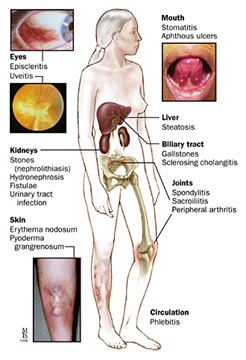Crohn's Disease
Crohn's disease is a chronic, inflammatory disease of the gastrointestinal tract. It is an autoimmune disorder, meaning your body's immune system mistakenly attacks healthy tissue in your body.
Crohn's disease is chronic (ongoing), and may appear and disappear at various times. Initially, it may affect only a small part of your gastrointestinal tract, but the disease has the potential to progress extensively.
Who Gets Crohn's Disease?
Crohn's disease appears early in life; approximately one-sixth of patients have symptoms before 15 years of age. Although the cause is unknown, doctors suspect a genetic influence, since many members of the same family may be affected. Crohn's disease affects the Jewish population more than the general population.

Crohn's Disease Symptoms
Crohn's disease often begins in a person's teens or twenties, though some patients experience symptoms even earlier. Most common symptoms include:
-
Abdominal cramps
-
Diarrhea
-
Delayed growth (in younger children), which often occurs before gastrointestinal symptoms begin
-
Weight loss
-
Fever
-
Anemia
There are different types of Crohn's disease, depending on which part of the gastrointestinal tract is affected. Each subtype of the disease has its own specific symptoms. Patients sometimes experience non-intestinal symptoms that are more problematic than the bowel problems. These include:

-
Colitic arthritis, an arthritis that migrates along the body and affects knees, ankles, hips, wrists and elbows
-
Pericholangitis, inflammation of the tissues around the bile ducts
-
Kidney stones
-
Urinary tract complications
-
Fistulas

Crohn's Disease Diagnosis
In the past, patients used to suffer with symptoms for years until they were given a proper diagnosis. Today, thanks to better imaging techniques and greater knowledge about Crohn's disease, the time between your initial doctor visit and the diagnosis and treatment phase is much shorter.
A diagnosis of Crohn's disease begins with a comprehensive physical exam. However, your physical examination may be completely normal. Your doctor will use a number of other diagnostic tools to confirm a diagnosis of Crohn's disease. Together, these findings will create a complete picture about the nature of your condition.
Diagnostic procedures include:
-
Imaging Scans
-
Flexible Sigmoidoscopy
-
Colonoscopy
Imaging Scans
An imaging scan is a noninvasive diagnostic procedure that allows your doctor to obtain detailed images of the affected area. A computed tomography (CT) scan uses powerful X-ray technology to produce the images.
Other imaging scans your doctor may recommend include:
Double Contrast Barium Enema X-ray
This is a specialized X-ray, using a contrast material to highlight the affected area. During the X-ray, your doctor can clearly see the right colon and the ileum (part of the small intestine), the two areas most often involved in Crohn's disease.
Before the procedure, you will need to clear your colon of any stool. Preparations may include a liquid diet, enema or laxative. During a barium enema:
-
A barium preparation (contrast material) is inserted through a rectal tube.
-
The barium outlines the colon, highlighting any abnormalities.
-
An X-ray is taken.
-
Your doctor can look for evidence of Crohn's disease.
Small Bowel Series
This is a fast, safe procedure for visualizing the small bowel. During this procedure:
-
You drink a barium preparation.
-
Overhead X-rays are taken at frequent intervals.
-
When the barium reaches your small intestine, a fluoroscopy is performed. A fluoroscopy is a specialized X-ray that takes real-time, moving images of your internal structures.
-
During the fluoroscopy, you will be moved into various positions.
-
These X-rays reveal the extent of the disease and where any obstructions are located.
Enteroclysis
This is a more invasive, complex diagnostic procedure. However, it is more sensitive at detecting certain abnormalities. You may be sedated and the doctor will pass a tube through your nose and into your gastrointestinal tract. It is similar to a double-contrast barium enema.
Flexible Sigmoidoscopy
Two common endoscopic procedures for diagnosing Crohn's disease are a flexible sigmoidoscopy and a colonoscopy.
A flexible sigmoidoscopy examines the rectum and lower colon. A sigmoidoscope is a specialized endoscope that is a thin, flexible lighted tube that your doctor inserts inside you to see the affected area.
A flexible sigmoidoscopy examines the rectum and lower colon. During the procedure:
-
Your colon must be clear of stool so your doctor has good visibility. Preparations may include a liquid diet, enema and laxatives.
-
Your doctor inserts the sigmoidoscope through the rectum and into the anus and large intestine.
-
A biopsy forceps may be inserted through the scope in order to remove a small sample of tissue for further analysis.
-
The procedure may cause some cramping or discomfort.
Colonoscopy
A colonoscopy examines the rectum and the entire colon. A colonoscopy allows for visualization further into the bowel than the sigmoidoscopy, in order to assess the progression of the disease and determine an effective course of therapy.
During a colonoscopy:
-
Your colon must be clear of stool so your doctor has good visibility. Preparations may include a liquid diet, enema and laxatives.
-
You are sedated before the procedure.
-
Your doctor inserts the colonoscope through the rectum and into the anus and large intestine.
-
A biopsy forceps may be inserted through the scope in order to remove a small sample of tissue for further analysis.
-
The procedure may cause some cramping or discomfort.



